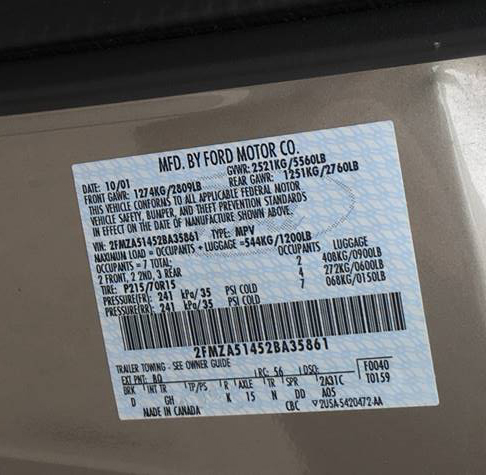Blog
Could You be Subject to DOT Regulations and Not Know It? (Part 1) Watch Your Weight
When working with clients, I periodically encounter situations where a client is unknowingly out of compliance with Department of Transportation (DOT) regulations. Many times, these issues relate to light trucks or vans that are occasionally used to tow trailers. There are passenger carrier rules as well as hazardous material rules, which I will address in Part 2 of this series on DOT regulations.
For this post, I will make two assumptions. First, I will assume that we are discussing vehicles being used in commerce. If they are driven for business in any way they are in commerce. The second assumption I will make is that these vehicles are being driven on public roadways. If you operate only on private property or are not operating in commerce, the DOT does not have jurisdictional authority over your operations.
Here, I will discuss only DOT weight regulations and the weight threshold that will trigger DOT regulations applicable to light trucks and trailers.
DOT Fleet Weight Regulations Can Be Confusing
The topic of DOT weight regulations tends to get confusing for three reasons:
1. Intrastate versus Interstate Operations
There are two types of fleet operations. One is called intrastate (For the sake of simplicity, let’s say that means never crossing state lines; more on that in a later post) and one is called interstate (crossing state lines). Depending on which type of fleet you operate and which state you operate in, the weight threshold that triggers a need for compliance can be different. For example, for intrastate fleets the state of Colorado threshold is 16,000 pounds GVWR (Gross Vehicle Weight Rating) / GCWR Gross Combined Weight Rating); the state of Arizona threshold is 18,000 pounds GVWR / GCWR; other states have different thresholds; and some states stick with 10,001 pounds GVWR / GCWR, which matches the federal government standard for interstate CMV definitions. In other words, depending on which state you’re in and whether or not you cross state lines, the threshold is different.
2. DOT Regulates Vehicle and Capacity Weight
The way that these weights are measured is not intuitive to those who have not dealt with DOT regulations before. These weights are not the actual weights of a vehicle or trailer, but instead include the weight of the vehicle plus the weight it can carry. These two weights add up to the GVWR. This information is usually posted on the inside of the driver’s door and on trailers. The label below is from a light-duty minivan:
3. Add Truck and Trailer Weights Together
It doesn't matter whether the weight rating is of a single vehicle (GVWR) or a combination of vehicles (GVWR + GVWR = GCWR). If it exceeds the threshold, then DOT regulations start to kick in.
To help explain why this is often missed, it may be helpful to look at an example. It is not uncommon for a three-quarter-ton truck to have a GVWR as high as 10,000 pounds, especially with diesels, which is just one pound shy of the federal GVWR limit that would require DOT compliance at some level. Let’s look at what happens if such a truck is used for either interstate or intrastate purposes:
- Interstate: If a trailer is then added to a truck of this type, the combination would be a CMV because the combined weight (GCWR) exceeds 10,001 pounds.
- Intrastate: In some states, the combination would qualify as a CMV once it hit 10,001 pounds, and in some states with higher weight thresholds it would only become a CMV once it hit that state’s threshold. Using Colorado as an example, if the trailer GVWR is 6,000 pounds (not uncommon for a dual-axle trailer), the combined weight of 16,001 pounds would now require compliance with DOT regulations specific to Colorado.
Even if you have quarter-ton trucks or vans, their GVWR can be 7,000 pounds or higher. A trailer with a GVWR of 3,001 pounds or higher would push the GCWR to 10,001 pounds.
CDLs Have a Different Threshold
Another somewhat confusing factor is that none of these thresholds mean that a driver must have a commercial driver’s license (CDL) to drive the vehicle. That is a different threshold set at a higher weight level. Many employers assume that if their drivers don’t need a CDL, then they are not subject to any DOT regulations. In fact, they may be required to keep driver qualification files, pull and check motor vehicle records, maintain medical cards, carry out road evaluations, ensure their drivers are not disqualified, keep hours of service records, and more.
To learn more about federal regulations, visit the Federal Motor Carrier Safety Administration (FMCSA) website. Questions about state-specific regulations can be sent to your Woodruff Sawyer account team or addressed to a state-specific enforcement agent, such as the state patrol or state police.
Follow these links for Part 2 and Part 3 of this series, on passengers and payment type and substances and toxins, respectively.
Knowing whether your fleet is regulated by the Department of Transportation or not has never been more important. Verdicts keep getting larger and more frequent. This article discusses that trend and some of the more common controls used to mitigate exposure.
Author
Table of Contents













